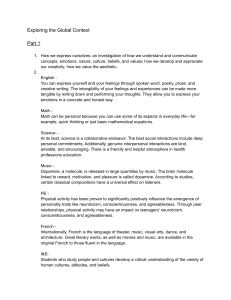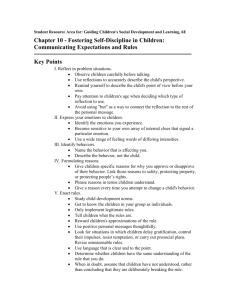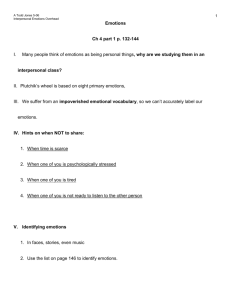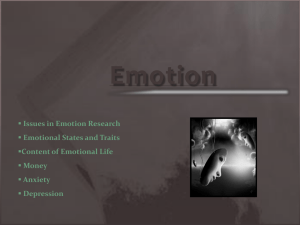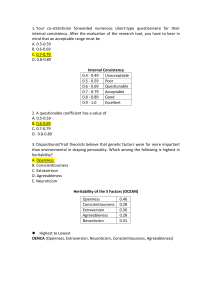More Specific Personality Study Guide
advertisement
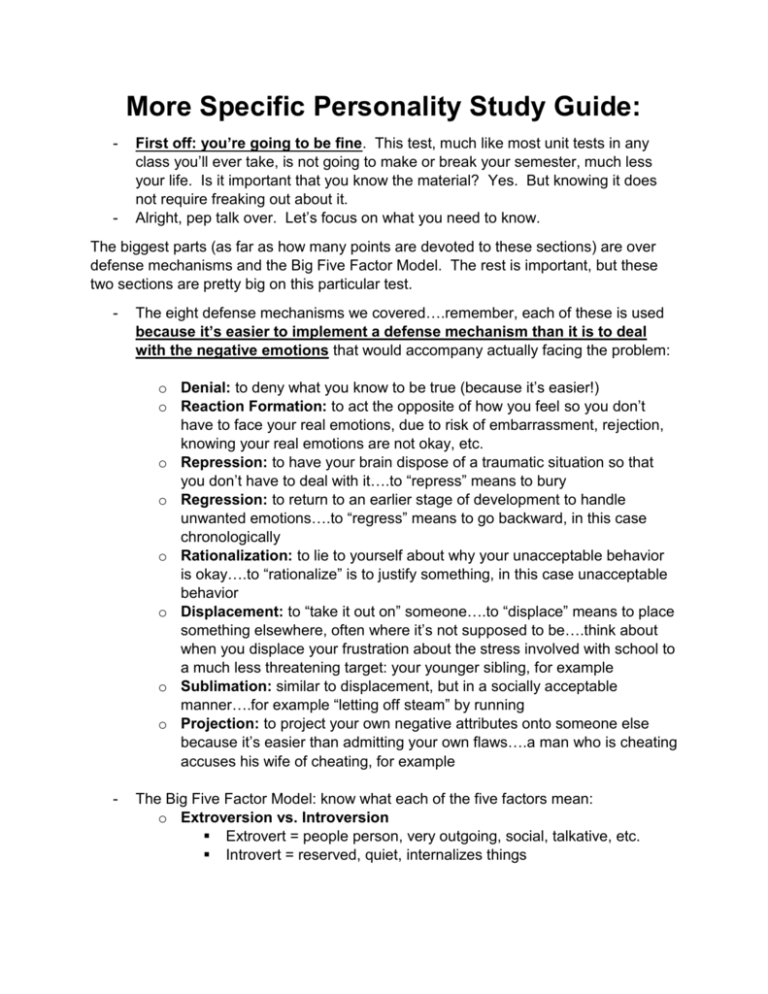
More Specific Personality Study Guide:
-
-
First off: you’re going to be fine. This test, much like most unit tests in any
class you’ll ever take, is not going to make or break your semester, much less
your life. Is it important that you know the material? Yes. But knowing it does
not require freaking out about it.
Alright, pep talk over. Let’s focus on what you need to know.
The biggest parts (as far as how many points are devoted to these sections) are over
defense mechanisms and the Big Five Factor Model. The rest is important, but these
two sections are pretty big on this particular test.
-
The eight defense mechanisms we covered….remember, each of these is used
because it’s easier to implement a defense mechanism than it is to deal
with the negative emotions that would accompany actually facing the problem:
o Denial: to deny what you know to be true (because it’s easier!)
o Reaction Formation: to act the opposite of how you feel so you don’t
have to face your real emotions, due to risk of embarrassment, rejection,
knowing your real emotions are not okay, etc.
o Repression: to have your brain dispose of a traumatic situation so that
you don’t have to deal with it….to “repress” means to bury
o Regression: to return to an earlier stage of development to handle
unwanted emotions….to “regress” means to go backward, in this case
chronologically
o Rationalization: to lie to yourself about why your unacceptable behavior
is okay….to “rationalize” is to justify something, in this case unacceptable
behavior
o Displacement: to “take it out on” someone….to “displace” means to place
something elsewhere, often where it’s not supposed to be….think about
when you displace your frustration about the stress involved with school to
a much less threatening target: your younger sibling, for example
o Sublimation: similar to displacement, but in a socially acceptable
manner….for example “letting off steam” by running
o Projection: to project your own negative attributes onto someone else
because it’s easier than admitting your own flaws….a man who is cheating
accuses his wife of cheating, for example
-
The Big Five Factor Model: know what each of the five factors mean:
o Extroversion vs. Introversion
Extrovert = people person, very outgoing, social, talkative, etc.
Introvert = reserved, quiet, internalizes things
o Agreeableness vs. Antagonism
How easy is it to get along with someone? “Agreeableness” means
it is easy to get along with a person. Someone who is an
antagonist often stirs the pot by pushing people’s buttons.
o Conscientiousness vs. Impulsiveness
Conscientiousness: everything must be “just so”….grades,
organization, punctuality….sometimes uptight
Impulsiveness: does not always think things through….free-spirited,
can be disorganized, acts on the spur-of-the-moment sometimes
o Emotional Stability vs. Neuroticism
Emotional Stability: copes well, level-headed, calm, “boat” never
gets rocked
Neuroticism: emotional, nervousness, does not cope well, irrational
at times
o Openness to Experience vs. Resistance to Experience
O-to-E: up for anything, into artistic ideas, often liberal-minded
R-to-E: “safe”, more of a one-dimensional thinker, often
conservative
Other helpful hints:
-
Skinner = Socialization (observational learning/behaviorism)
Jung = Analytic Psychology
Adler = Inferiority Complex (feeling inferior {less than} and acting “big and bad” to
overcompensate for low self-worth)
Erikson = emphasized mother/infant relationship
Maslow = self-actualization (hierarchy of needs….reach your hands as high as
you can)
Congruence is in place when SELF-CONCEPT = REALITY
Type A = uptight, anxious, anal
Type B = opposite of A, of course….relaxed, calm, “breathing easy, bumming
around”
Id = pleasure principle (“Devil”)
Ego = moral principle (“Angel”)
Superego = intermediary (“You”)
And finally, know a little bit about the number of personality tests we took and be
able to explain one and whether it was valid (Oreo, Pig, GT, Color, Five Factor,
Rorschach, Thematic Apperception).
You are going to be FINE….
